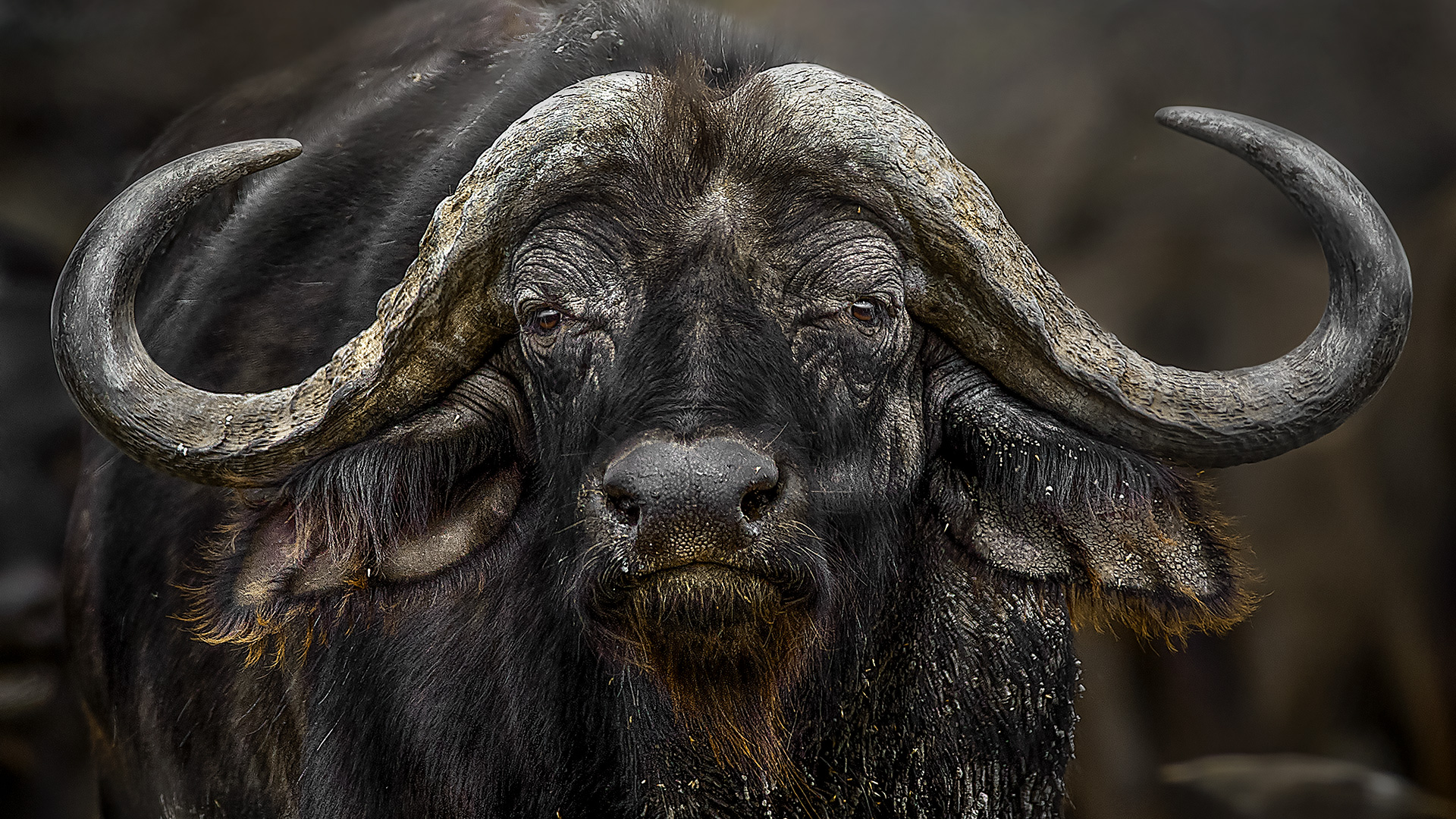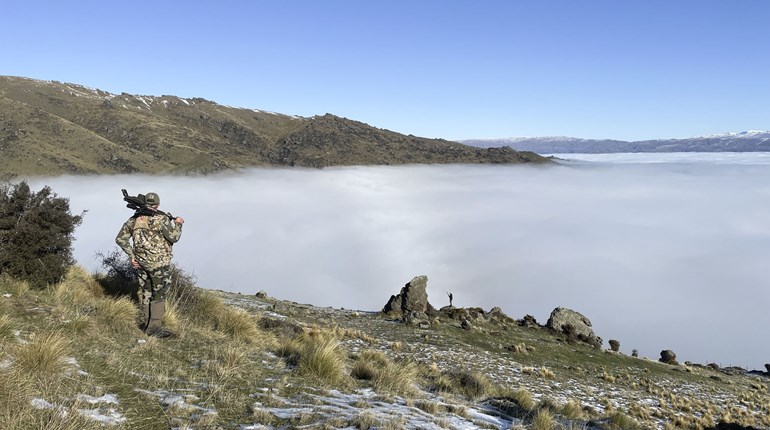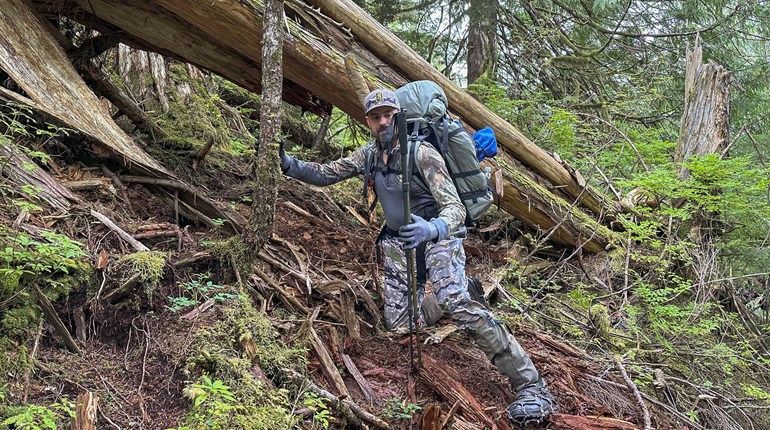
The Cape buffalo tracks are sharply cut into a white sand road. A tracker is kneeling over them and nodding. He turns his face to me and smiles as he says, “Dagga boys.”
I look at the prints and my eyes follow the tracks across the sand road in bright morning light and into trees, waist-high brown grass and dry fallen leaves. I know at the end of those tracks are 2,000-pound buffalo. These tracks are Tanzania’s Selous condensed to sign left in sand, as they are big, were pushed into the earth by a dangerous-game animal and loaded with uncertainty.

Yet, they are also as simple as the opening pages of a classic African novel presenting itself page by page or, in this case, track by track. Still, to me, following these tracks, as we’ve done for seven days now, feels more William Faulkner than Ernest Hemingway, as Faulkner took us into the surreal quality of a forest and its wildlife (see Big Woods); whereas Hemingway loved the inner drama of the inevitable tragedy of man (see The Snows of Kilimanjaro). Hemingway was always trying to make the mysterious understandable (see Death in the Afternoon). Faulkner, though hardly known for African adventures, never tried to make the mysterious sensible. Instead, he used his lyrical words to tiptoe into the mysteries of the forest and the inner self, as if dusk is forever deepening into darkness around us.
But still, those two authors’ perspectives meet in this reality of tracking Cape buffalo, because though doing this kind of hunt is as simple as following big hoofprints in the sand, it is nevertheless fraught with the unknown of what might happen when we do meet … what is at the end of a track. Indeed, to be ready for the buffalo I have to push away my imagination and stay in the moment, as Hemingway would have advised.
What also surprises me is that none of this reminds me of Robert Ruark, even though his classics (Horn of the Hunter and, especially, Something of Value) gave me, as a teen, the basis of my worldview of this wild, romantic and complicated part of Africa. Today though, I find that Ruark’s Africa is past, as the aftershocks of colonialism have long since grown into other things.

But then, it can still be wild. I had one reminder of this when I heard the story of one of the men serving us in Mkwawa Hunting Safaris’ lovely camp. His name is David. He is a small man with a very polite smile and quiet way. But one night some years ago, after he’d helped dig a pit to catch a hyena that had been raiding the camp, he forgot the pit was there when he went out to pee. Like in a cartoon, they’d put sticks and leaves over the hole and baited it with dried meat. When David stumbled out to relieve himself, he fell into the pit. The thing was, the hyena was already in there. He screamed. The hyena made its cacophony of sounds. No one came to help. The hyena used its muscular jaws to push its canines into David’s arm, chest and head, but David managed to get on the hyena’s back and to get it in a choke hold. They battled like this for an hour before David choked the spotted hyena to death. David bashfully showed me his scars while he poured me a drink.

I am brought out of these reveries when Jamin Jamal ([email protected]), my PH with Mkwawa, waves a hand at the tracks. Jamil is 40 years old today and has a double rifle in .500 Nitro Express over his shoulder with the barrels in his left hand. “Come. We’ll follow these two bulls. The tracks are fresh,” he says.
We enter the forest as we have for days; that is to say, quietly and with controlled expectation. There is waist-high tan grass, dried leaves in late July (winter in the Southern Hemisphere) and trees spaced out by mostly 10 or 20 feet. The ground is sandy and hard an inch down. The forest grows thick ahead, but we know it will open into long grass here and there and that the bulls will graze before they bed in the heat of the day.
 The author’s PH carried a .500 NE double, a comforting sight when you’re trailing game that leaves tracks the size of pistons in giant diesel engines.
The author’s PH carried a .500 NE double, a comforting sight when you’re trailing game that leaves tracks the size of pistons in giant diesel engines.
Jamin is a Tanzanian of four generations. He has young children, an easy humor and has stopped buffalo charges with his .500. He directs his trackers in Swahili and helps them on the track if they get stuck. When they find a track they’ll point with a short stick taken from the ground and whistle lightly.
They stop and Jamin signals them with a wave of his hand to fan out. The bulls had been grazing here and they need to find where the tracks leave this area.
I lean my rifle against a large tree and watch them. I can see tracks here and there, but I don’t have the skill to read them. I don’t want to get in their way or to step on the tracks in the leaves and grass and so I watch as I have been doing all week. I look down at my rifle and I am no longer angry about what has happened. I had a beautiful Mossberg Patriot in .375 Ruger when I arrived at JFK to fly on Air Emirates along with Frank Zitz. Frank is a renowned taxidermist. If you’ve been to any Cabela’s store or to Johnny Morris’ Wonders of Wildlife in Springfield, Mo., you’ve seen his work. Frank and I hired a travel agent who specializes in booking flights and taking care of other details for travelling hunters, but though this agent has decades of experience, he didn’t know Emirates requires guns to be checked in two days before departure. In short, we were told there was no way they would let us on the plane with our rifles.

Frantic phone calls were made and soon our guns were sent home by the driver who’d taken us to the airport, and our outfitter for this adventure, Link’s Wild Safaris, assured us they had rifles in Africa we could borrow. But I had practiced with the Mossberg. It can shoot. It is comfortable to carry. It grouped three shots into an inch and a 10th at 100 yards with Hornady’s .375 Ruger DGX Bonded 300-grain bullet. Going into the bush for Cape buffalo is picking a fight with dangerous game. You want to be sure of your rifle in such a situation—and I can flat-out shoot that wonderful little Mossberg. I’d put 100 rounds of Hornady through that rifle. I can pick it up and shoot fast on moving targets. No rifleman wants to go afield without a known and trusted friend in a gun, yet here I was doing it … .
The outfitter did have and use Hornady DGS 300-grain ammunition in .375 H&H Mag. And he had two very old Model 700s for us: one topped with a Zeiss from maybe the 1980s and the other with a Leupold that was just as old. The rifles shot 3-inch groups for us off a truck’s hood at 100 yards. I told the PH I didn’t want to take a longer shot than 100 yards on buffalo with these rifles and he said that would not be a problem.
A tracker whistles and we are off again following the tracks of the two bulls. They meander into a thorn thicket and I remember two bulls from the day before. We didn’t see them until they were 12 yards from us. Even then there was no shot. Only horns moving in the thorn brush and then huge black bodies going away.
A tracker kneels down and pushes a finger into a pile of buffalo dung. “Warm,” he whispers.

We are stepping carefully now, but for a few minutes it isn’t necessary to be silent, as a group of bushpigs has come close. Their many quick-moving feet sound like crinkling newspaper in the dry leaves. I watch them and smile. We have seen so much on this trip into the Selous—wildebeest, impala, zebra, eland, hippo in the waterholes, warthog, impala, kudu, elephant, baboons … even a leopard in the headlights. We haven’t seen the lions, but their tracks have been in the sand of the roads and we’ve heard them roaring at night.
This is a new concession for Jamin and Mkwawa. Their old concession, along a river, was so well maintained and protected by them that the Tanzanian government decided to make it a national park. This other concession was leased to them in recompense. In just a year, without their protection, Jamin tells me, 95 percent of the elephants and so much more game has now been poached out of their old area.
“We had 27 trucks patrolling that property,” says Jamin. “But now, game rangers have one truck that always seems to be out of fuel. This is Africa. Hunters are these animals’ best defense.”
Still, they are excited about this new concession. It has not been hunted in years. It has huge buffalo—many over 45 inches—and plenty of game. During the hunt we do find evidence of a poacher who’d killed and dried the meat of a zebra. But Jamin assures me they have that under control.

When they temporarily lose the track again I wait in thick brush alongside an opening of maybe 10 acres. I can see impala feeding out in it. Before long Jamin softly whistles and the trackers come close and move leaves with their sticks. They see the tracks and are again following.
This reminds me of a track we followed a few days before of four bulls we slipped to within 30 yards of. The bulls looked big to me, but Jamin assured me they were all a little small and then a herd of impala winded us and went running through and the buffalo stampeded away. When the bulls ran, they sounded to me just like the bulls do when they come down those canyons of streets in Pamplona.
One of the trackers kneels down and points. He turns to look at me and nods and his lips part into a broad smile. “Dagga boys,” he whispers.
Jamin and I stay low as we try to slip in like leopards. At 60 yards we stop. We can see a bull bedded. We can see his black back, his nose and his heavy bosses.
“He is an old bull,” says Jamin, “but I cannot see how wide he is.”
This is day eight and I have loved this hunt and this now three-hour trek along these bulls’ tracks. The bull is old and I have never shot a Cape buffalo. Old and with character are all I hope for. I slowly go onto the sticks. I know I will have to wait until this bull stands. I expect to have to wait a long time, but then the bull is up. The late-morning winds are swirling. These bulls don’t always trust their eyes, but they trust their noses. I have passed on other shots this week, as they were not ideal. This time I see the bull’s shoulder as he steps into a 3-foot window in the dense bush and I shoot.
We then see two bulls—or parts of them—disappear into the bush. We take a breath. I reload my rifle. And we follow. The ground opens up and we see blood in the grass. And then the bulls are running, but there is no shot. We go another 100 yards and, though I don’t know it, one of the trackers is using Jamin’s phone to record the hunt from behind. This next sequence of events takes about 5 minutes, though it feels like 30 seconds.
The bull I shot is lying down with his head up. We can’t see his body. The other bull is standing nearby. This bull knows we are here. He is pacing, but he doesn’t want to leave this old bull.
We circle to find a clear shot from about 80 yards. Just as we get there, the mortally hit bull leaps to its feet and turns to us. He is moving his head from side to side to find us. “Shoot,” says Jamin, and I already am.
At the shot the bull turns and runs. I shoot again and the bull slams into the ground with a broken hip. I reload and run to a better position. I put two more shots into the bull’s shoulder. The bull is down and is moaning.

In seconds it is over. The bull probably once had big, sweeping horns, but now one side is broken from the head of this 15-year-old warrior and the other is rubbed short. So no, he is not the trophy that many in this concession are, not if you go by score, but he is wild and big and lived a long life here with lions and in the big herds and with other dagga boys. His left ear is ripped to the base from some long-ago battle. Scars are all over his face. He is perfect.
“He was about to charge,” says Jamin with a laugh in this voice as he puts down his double rifle. “He was looking for us. Your shot convinced him to run instead.”
“I wish he had,” I said, and I meant it.
I want this animal, above anything else I have hunted, to have and to keep its dignity. Hemingway wrote in The Garden of Eden that after we kill, the only dignity an animal has left is what we give it. I think that is true and I was pleased to see Jamin, the trackers and the game ranger there with us give the buffalo, this hunt and this place the respect it demands.
The Mossberg Patriot
I leaned my Mossberg Patriot in .375 Ruger alongside so many other dangerous-game rifles at an “African shoot” at my club. The 25 competitors had all been to Africa many times. Some still dreamed of dangerous-game hunts. Several looked at my rifle beside all their classic doubles and bolt actions. “What do you have there, Frank?” asked one. “A Mossberg Patriot in .375 Ruger.” They handled the Mossberg as I looked at their rifles. “Smooth,” said many.
And then the shoot started. The competition is simple. Competitors must use .375 or larger. All the targets are at 100 yards (75 yards for those with open sights). The competition begins with a standing elephant target. Next, there are rising buffalo (singles and pairs). Finally, there is a running lion (it is on a cable). Each competitor shoots a total of 20 cartridges—if they can load fast enough.
As the shooting is timed and some targets are moving, there is pressure. Many people short-stroked and jammed their bolt guns. Others fumbled with cartridges as they loaded double rifles. The Mossberg never had an issue and I was in the running to win until that lion. We use a running deer target at the club and some of the members can really shoot it. They had me that day. I finished in the middle of the pack. But my rifle never had an issue and it was a joy to shoot. At $560, it cost less than the sales tax would on many of their guns.




































